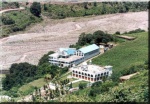Template:AOW147: Difference between revisions
Hari singh (talk | contribs) No edit summary |
Hari singh (talk | contribs) No edit summary |
||
| (4 intermediate revisions by the same user not shown) | |||
| Line 1: | Line 1: | ||
{{aowh|[[Gurdwara Nangali Sahib]]}} | {{aowh|[[Gurdwara Nangali Sahib]]}} | ||
{{pm|Image:Nangalisahibpoonch.jpg|'''[[Gurdwara Nangali Sahib]]'''}} | |||
'''Gurudwara Nangali Sahib''' is situated in the lap of a picturesque hill and on the bank of Drungali Nallah. It is about | '''[[Gurudwara Nangali Sahib]]''' is situated in the lap of a picturesque hill and on the bank of Drungali Nallah. It is about 4 kms from {{wiki|Poonch}} town in {{wiki|Poonch district}}, which is the smallest of the 14 districts of [[Jammu & Kashmir]] state. It is one of the oldest shrine of the [[Sikhs]] in [[India|Northern India]]. | ||
Presently the [[Gurudwara]] complex consists of the main [[Gurdwara]] building, a [[Langar Hall]] and about 70 living rooms. Large number of devotees belonging to all faiths visit this shrine from all over the country every year. | |||
The [[Gurdwara]] was established by Thakur Bhai Mela Singh ji (Fourth successor of Sant Bhai Feru Singh ji) in 1803 AD. [[Maharaja Ranjit Singh]] visited | This holy [[Sikh shrine]] is approximately 240 Kms from {{Wiki|Jammu}} city by road (but only about 150km {{wiki|as the crow flies}})which in turn is connected to rest of the world via road, rail and airline network. Pilgrims outside the state may use railways or air services up to {{wiki|Jammu}} and then travel by road to {{wiki|Poonch}}. | ||
The [[Gurdwara]] was established by Thakur Bhai Mela Singh ji (Fourth successor of Sant Bhai Feru Singh ji) in 1803 AD. [[Maharaja Ranjit Singh]] visited Gurdwara Nangali Sahib in 1814 and was very much impressed by it. <!--He attached an estate with the Gurdwara sahib. He again attached four villages with the [[Gurdwara sahib]] in the year 1823.---> {{aowf|Gurdwara Nangali Sahib}} | |||
Latest revision as of 03:05, 8 April 2011
Gurudwara Nangali Sahib is situated in the lap of a picturesque hill and on the bank of Drungali Nallah. It is about 4 kms from Poonch town in Poonch district, which is the smallest of the 14 districts of Jammu & Kashmir state. It is one of the oldest shrine of the Sikhs in Northern India.
Presently the Gurudwara complex consists of the main Gurdwara building, a Langar Hall and about 70 living rooms. Large number of devotees belonging to all faiths visit this shrine from all over the country every year.
This holy Sikh shrine is approximately 240 Kms from Jammu city by road (but only about 150km as the crow flies)which in turn is connected to rest of the world via road, rail and airline network. Pilgrims outside the state may use railways or air services up to Jammu and then travel by road to Poonch.
The Gurdwara was established by Thakur Bhai Mela Singh ji (Fourth successor of Sant Bhai Feru Singh ji) in 1803 AD. Maharaja Ranjit Singh visited Gurdwara Nangali Sahib in 1814 and was very much impressed by it. .....More

